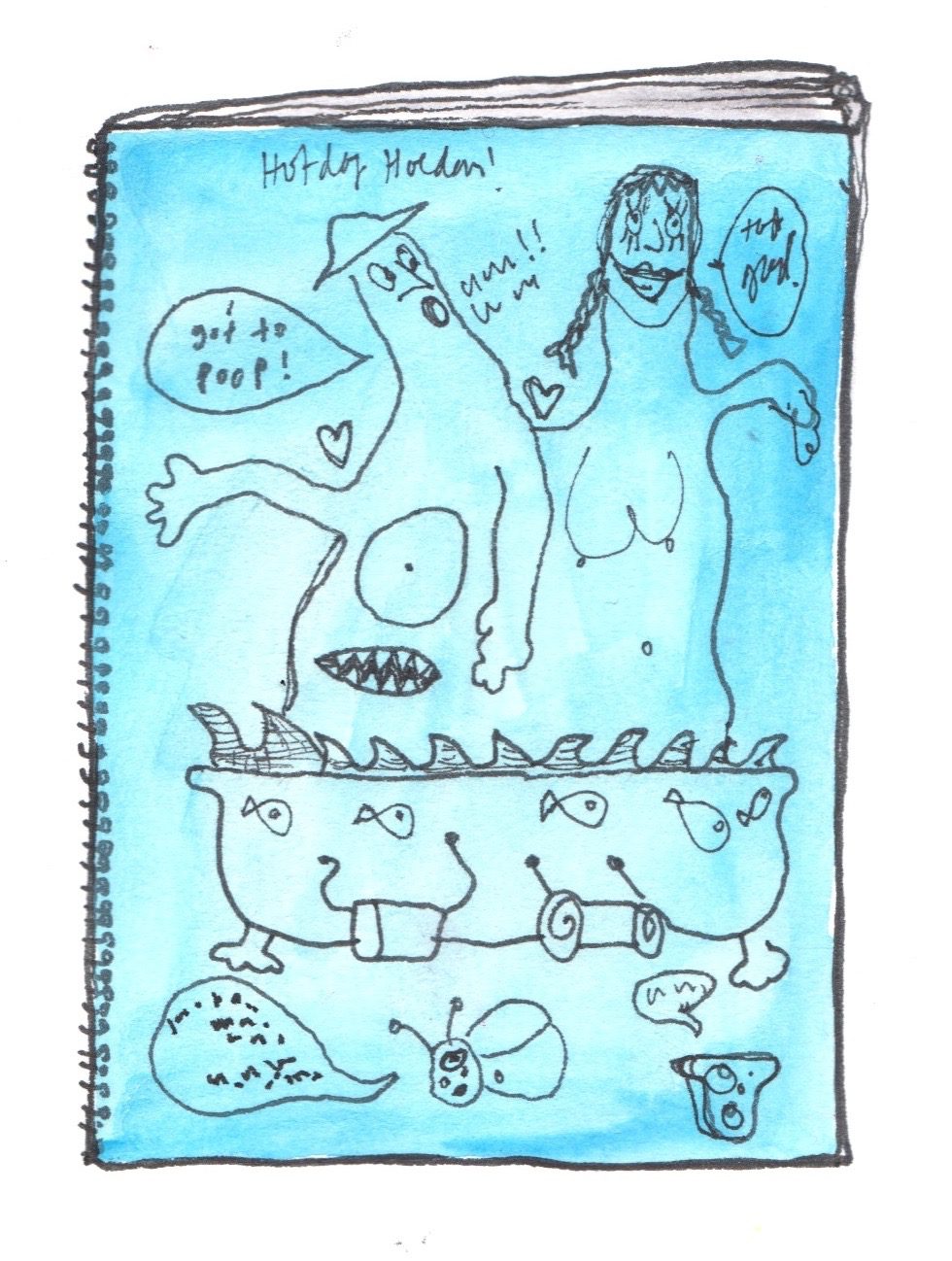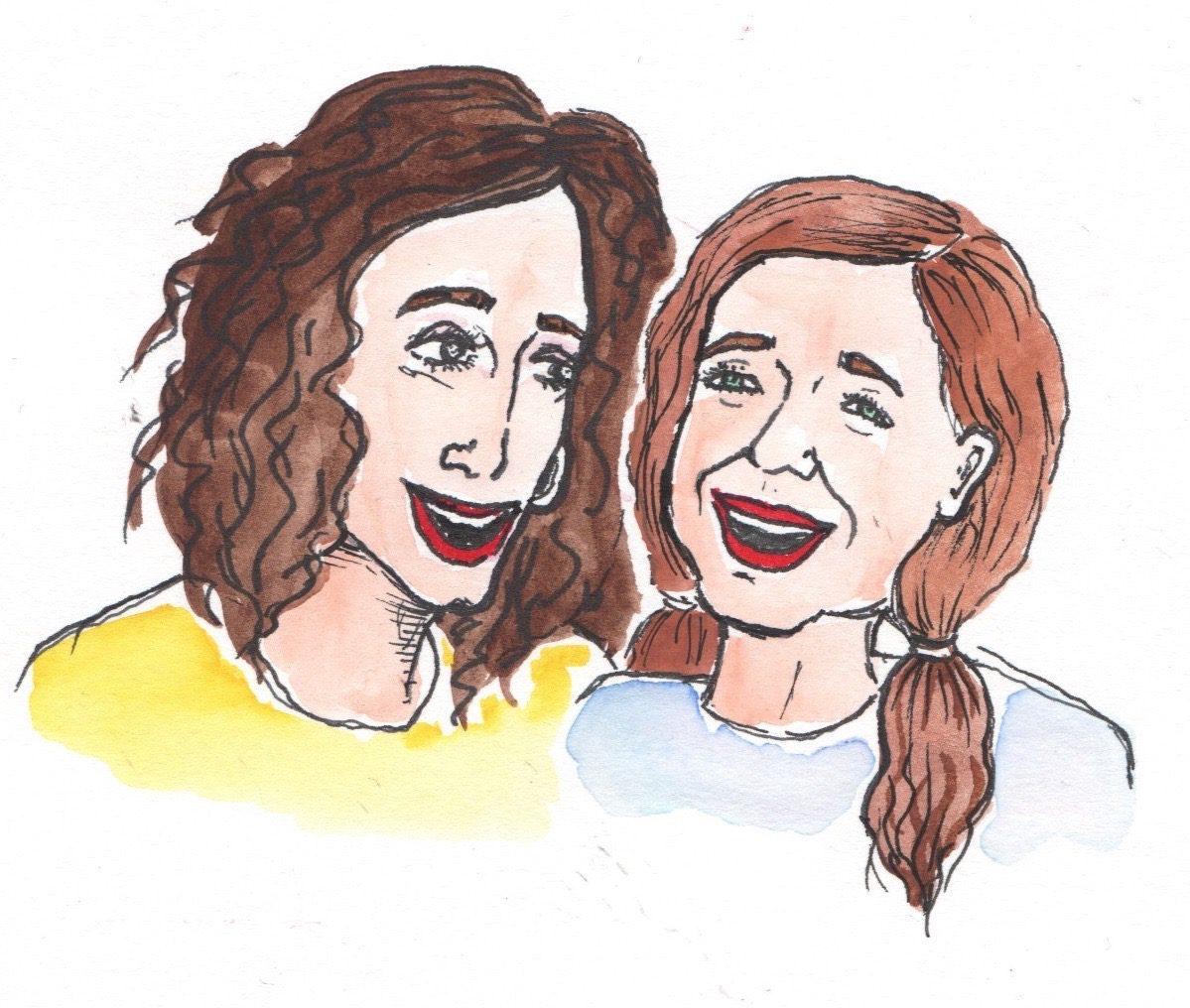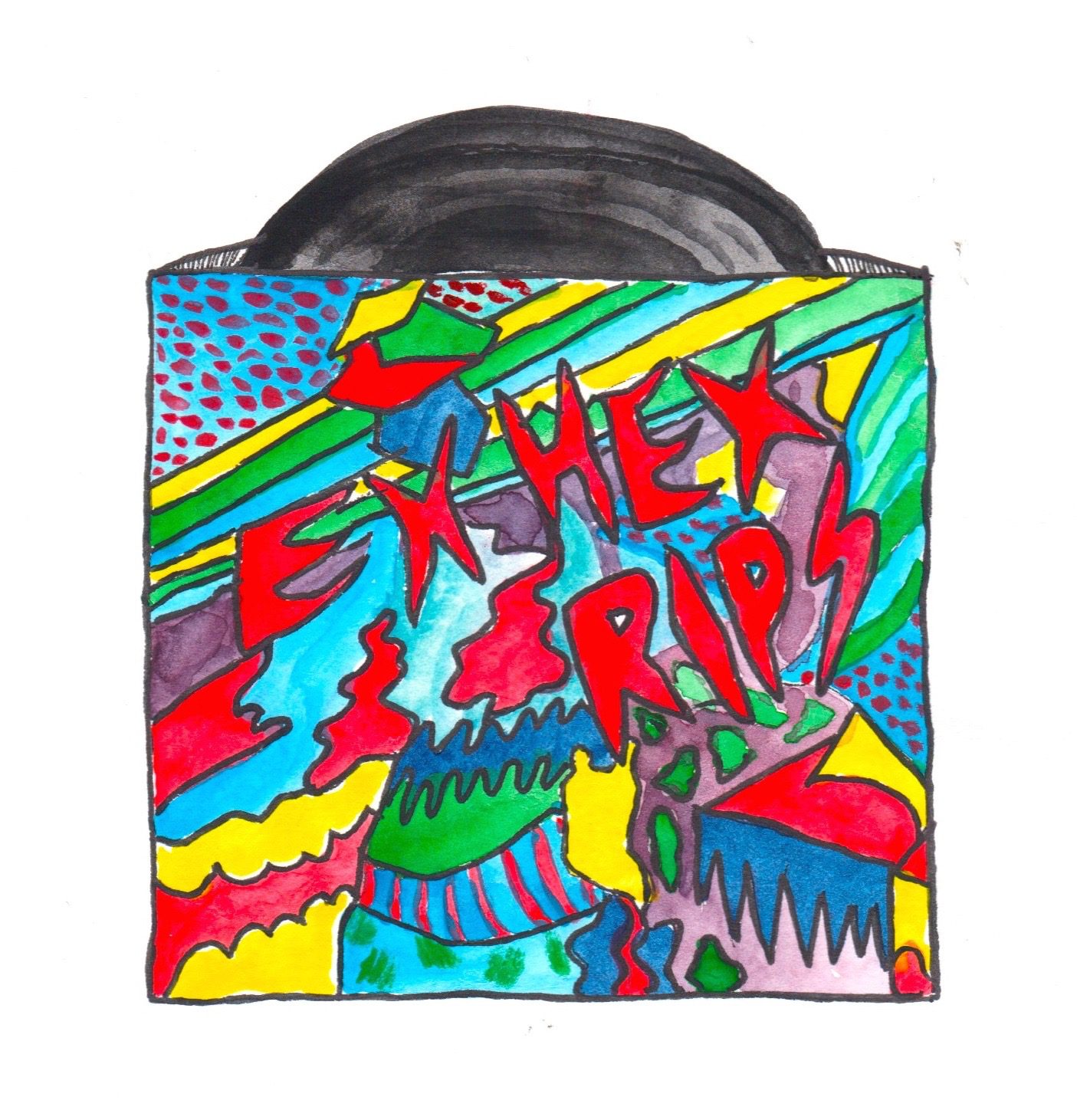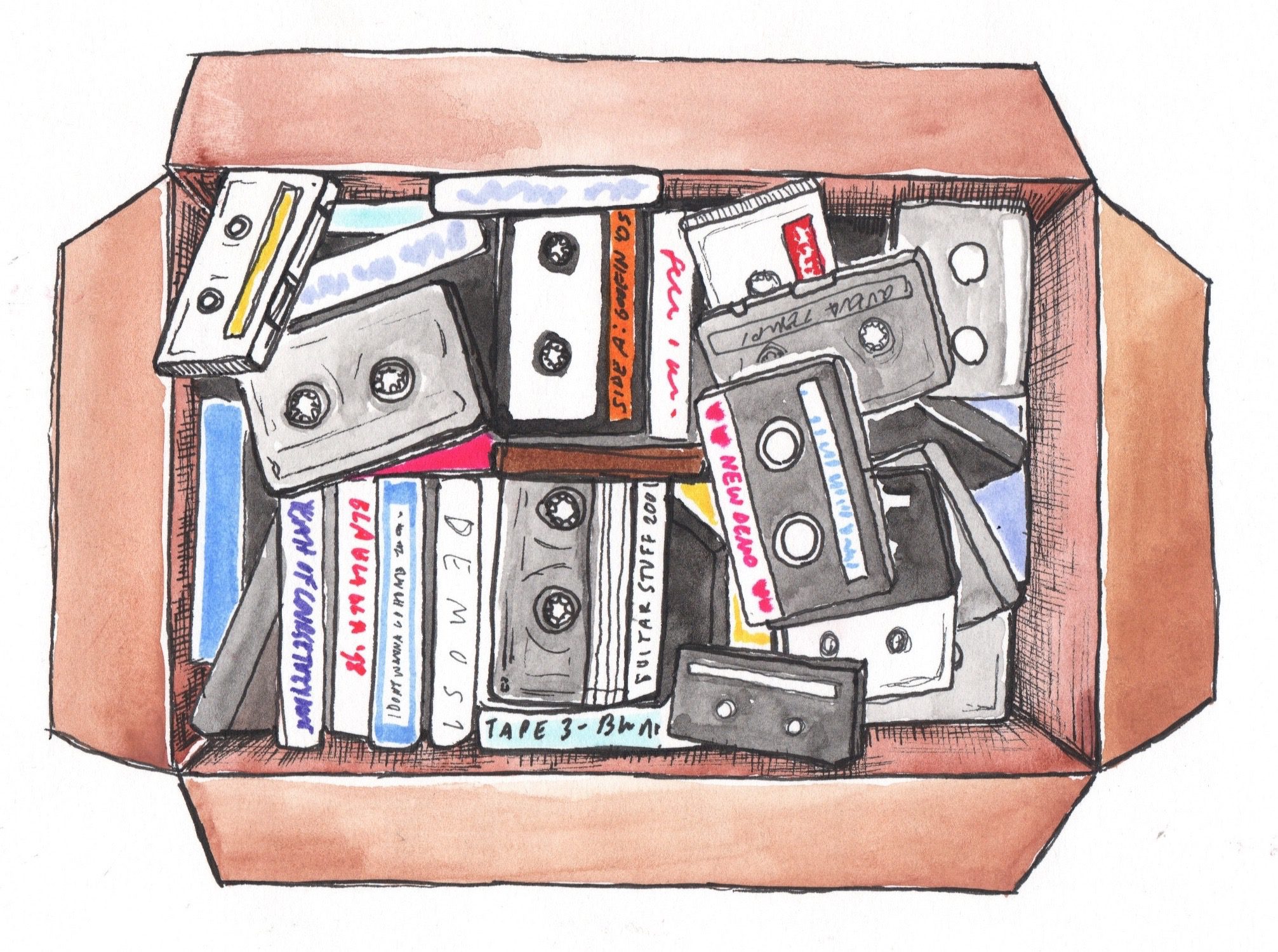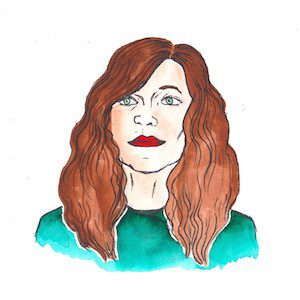
As a musician you’re traveling around all the time on tour. You have to learn to live with as few things as possible. When I’m home—and I’ve lived in the same house now for about ten or eleven years—I’m surrounded by stuff on my shelves, weird things I’ve found somewhere like a ukulele or snowmen—junk, but not necessarily stuff I’m emotionally attached to. Looking around my living room now, however, I do see one thing that I am really attached to because it reminds me of time I’ve spent hanging out with my friends, Winston and Emily, and my boyfriend, Jonah.
We like doing all kinds of structured activities together—playing cards, going bowling, etcetera. About five years ago we went through a phase where one of our big activities was doing exquisite corpse drawings. You know, that game where you fold the paper in three parts and each person draws a part without knowing how it’s going to look at the end?
Well, I didn’t know it at the time, but my friend Emily was saving all of our drawings! As a birthday present she made me this really cool book where she compiled them and cut up the pages so they could be recombined into other variations. The book isn’t fancy. It’s like something you’d put together at Kinko’s. But I was really surprised that Emily kept those drawings and even more surprised that she made them into a book for me.
When we made these drawings together we didn’t set out to do them as “art” or with any intention of being “creative.” It was more a fun party game. We made the drawings on scrap paper with Sharpies and ballpoint pens, whatever we had laying around.
When you play the exquisite corpse game it’s not like you’re consciously trying to make something significant, and maybe that’s why it’s fun. You’re just sitting around and talking and creating without really thinking about it. We made monsters with chickens in their stomachs, gigantic mouths, and maybe a loaf of baloney in a bathtub… stuff like that. Looking at them now, I see that some of them are definitely not great, but I think some are cool and pretty weird—in a good way.
I hadn’t really thought about it before, but I do see a connection now with making music. When I’m writing a song, I like to play it on a really shitty guitar with old strings that isn’t even plugged into an amp because it makes me feel like I’m not actually, “writing a song.” When I’m writing lyrics it has to be on some junk mail or on the back of an old envelope so it doesn’t feel “official.”
If I sat down and said to myself, “I am going to make a song now” I couldn’t do it. I get my best song ideas when I’m doing or thinking about other things, like if I’m rushing around because I have to leave the house in fifteen minutes one will pop into my head. But if I have to think about writing one, it could take fifteen hours. Maybe more! If I’m not feeding my brain, and freeing up my creativity, I could go two years without writing a single song.
Sometimes I think I do certain things to trick myself into making things that last by acting as if they won’t. Maybe that’s the way drawing is similar to writing a song. If I say to myself, “It doesn’t matter. It’s just going to be thrown away,” I stop thinking about what I’m doing as something precious. I can be at my most creative and let my ideas out when I’m not thinking, “I am going to be creative now!”
My favorite thing about the book Emily made for me is the way she cut up the drawings so they could be remixed and made into new combinations. When you’re making an exquisite corpse drawing you never know what’s going to happen next. No one knows what anyone else is drawing, or where the picture will go. You start off with one panel, but then you fold it over and hand it off, and someone else brings in something new, and so on. Sometimes it works and sometimes it doesn’t, but either way you’ve made something together.
Musically that can also happen, whether improv jamming or recording an album. Your first demo may not sound the same as the “finished” song even though some of the original elements remain. It evolves as you open your mind up to the process and involve other people in the work you create collaboratively.
I suppose it’s possible that visual artists become more attached to objects than musicians, who work more in the realm of abstraction. As a musician you may have a physical record that you can look at, but the songs on the album are not themselves material or unique in the same way as, say, original paintings.
When I think about the music I like listening to, I want to have easy access to it on my computer or phone but most of the time I also like to have the actual record to hold in my hands. I want access to the music but also access to the memory. Where was I when I first heard this song? Bought this album? Brought it home and played it?
When I’m making my own music, I often reach back into this folder I’ve kept of lyrics I’ve written forever ago. I also have a vortex of old cassette tapes, which I keep in overflowing boxes. I saved the tapes because I always feared that maybe there was some usable idea somewhere that I’d forget about otherwise, but of course I didn’t catalogue any of the tapes. I would just run out of room on one tape, and then throw it in a box and start recording on a new one. A couple of years ago when I was feeling really blocked I tried to go through all the tapes but I only got through maybe a tenth of my collection.
Most of the time there was like one idea played about fifty times over a few days with different variations. When I listened back, I was like, “Oh! Bad, bad, bad ideas!” but like the exquisite corpse drawings, I didn’t necessarily make these tapes thinking they would all became amazing songs. I was just tossing ideas around that became material through the process of recording them. Some of these old tapes may become actual songs on an actual album someday, but it’s also okay if they exist only as memories of who and where I was when I made them.
I still record ideas and songs, but of course I don’t record them on cassette tapes anymore. I changed over to digital in the 90s, and maybe in the future I’ll go to another format that hasn’t even been invented yet. It’s funny looking back at these things now. The stuff I’ve saved over the years aren’t just mementos of the past. They’re also reflections of the memories my friends and I have made together. That’s what I want/need/love most.
***
Wanted/Needed/Loved: Musicians and the Stuff They Can’t Live Without is an illustrated column where musicians share the stories behind meaningful objects. As told to Allyson McCabe and illustrated by Esme Blegvad.
***
Mary Timony is a Washington, DC-based singer-songwriter and guitarist. In addition to her solo recording projects, Timony has been a member of influential bands including Autoclave, Helium, and Wild Flag, which also included Sleater-Kinney members Carrie Brownstein and Janet Weiss. Timony currently fronts the all-female power trio Ex Hex, with bassist/vocalist Betsy Wright and drummer Laura Harris. Ex Hex’s 2014 debut album, Rips, has been lauded by Rolling Stone as “a glorious exercise in stripped-down, straight-up rock & roll,” and it made NPR music critic Ken Tucker’s top albums of the year list. Ex Hex is currently touring internationally.


